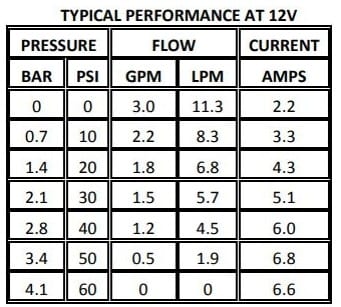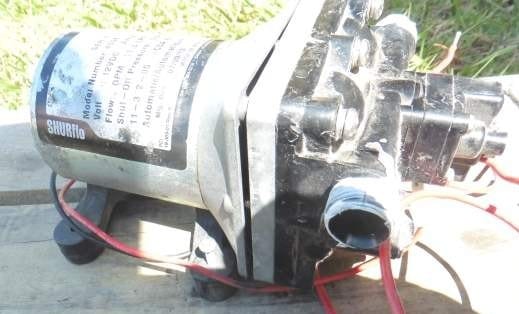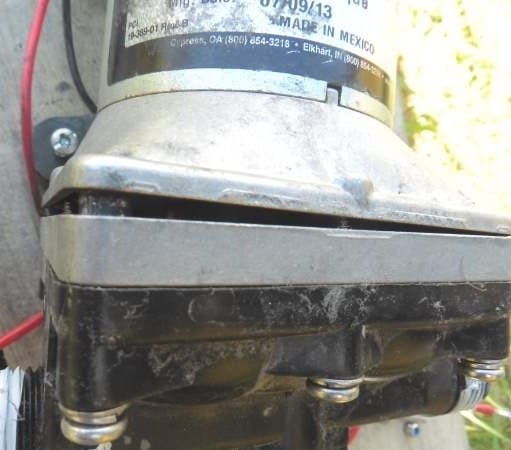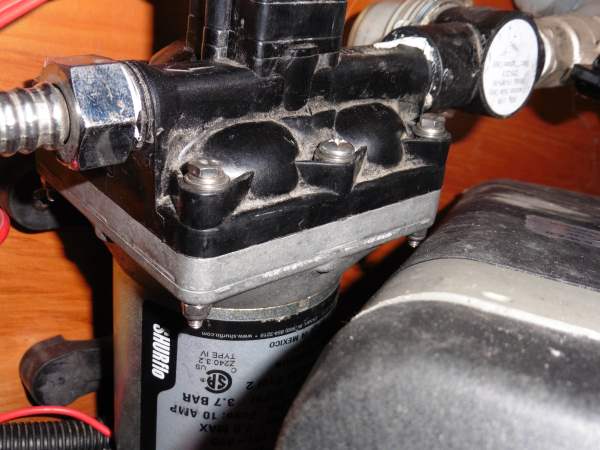Best Way to Solve RV Water Pump Issues
Today, we look at Motorhome and RV 12 volt water pump problems, what to do when going boon docking or on long term excursions in remote places and even frequenting RV parks. We look at different brands and the different specs and how that changes the behavior of your taps, shower and flush toilet.
What is the difference between LPM and Pressure
To make it simple, I will try to paint a picture that is hopefully familiar to everyone.
Lets imagine a water tank on a hill. From the tank runs a 13mm (1/2 inch) pipe to a shower 10 meters away. A tap is fitted in the pipeline by the tank. To have a shower, you open the tap fully so that the only restriction to the water flow is the shower head. You find that the water exiting the shower head is ample for a shower but it is not spraying properly.
You replace the pipeline with a 25mm(1 inch) diameter pipe and try again. The shower seems to stay the same. What we have done is increased the volume of water going to the shower but the pressure is still the same.
To increase the pressure, we need to raise the tank to a higher level or raise the water level inside the tank. It is like diving. The deeper you go, the higher the pressure. As long as the pipeline is big enough to feed the shower, we do not need to increase the pipe diameter.
If we were trying to fill a bath instead of having a shower, the big diameter pipe will be the answer. You can then remove the shower head and have the pipe run straight into the bath tub. The bigger the pipe, the more the volume of water that enters the bath every second.
So, the shower head restricted the water volume. With a raised tank, the pressure increases which will force the water through the shower head, creating a strong spray.
With higher pressure, the bath tub will also fill quicker. Thus, without restrictions, increase in pipe diameter as well as pressure make a difference.
It gets much more complicated than this, but for the RV application, it should suffice.
Conclusion
To save water and have a descent shower, get a restrictive shower head and a high pressure, low volume pump. This is the ideal for a Motorhome or RV.
How It Works
In my own Motorhome, I am currently running a ShurFlo 4008-101-A65 with the following specifications:
The rating on the pump is 11.3 LPM and 55PSI
LPM is the abbreviation for Liters Per Minute and shows the flow rate.
PSI is the abbreviation for Pounds Per Square Inch and shows the water pressure.

What does it mean?
If you run a clear hose straight up in the air and you switch the pump on, the pump will push the water up in the hose until the weight of the water is too much for the pump to handle. Climb a ladder (or use a chopper) to find where the water level settled in the hose. Cut the hose off just below the level so that the water starts flowing over the top of the hose.
Catch the water in a bowl for exactly one minute. Measure the amount of water in the bowl. If it is 1.9 litres, then the water pressure at the pump is 50PSI according to the graph shown above.
So, clearly, the pump is running at its maximum pressure that still creates a minute flow of water.
Now, remove the clear hose from the pump connection. All of a sudden, there is no water resistance for the pump. It can freely pump water to its maximum capacity. The pressure is zero PSI and if you catch the water in a bucket for exactly one minute, it should measure 11.3 liters.
Now that you know all this, lets apply it to determine what pump you need for your RV.
Which One Should I Get
There are hundreds of differently rated pumps on the market. The wrong choice can cause you a lot of drama or frustration.
Things To Keep In Mind
- The higher the pressure, the more likely to spring a leak somewhere.
- The less the pressure, the more likely you will have a drizzling shower or poor toilet flush.
- High volume pumps need larger diameter pipes.
- Micro shower heads create high pressure and low volume which save lots of water and makes for a comfortable pressure shower.
The ideal is thus a medium pressure pump with a medium to low volume rating. More details further down.
Different Types and Brands
I have had a few water pumps over the years including one ShuFlo. ShurFlo is good but not necessarily the best. The previous one lasted around 6 years which I think is lousy. We are only 2 people so it did not work that hard.
I got a used Flojet to replace it. The Flojet was a disaster. I could not get it to keep going for longer than a month at a time before the next issue cropped up. I cannot blame it for it was not a new unit. I replaced it with a brand new Shurflo that is currently installed. I also bought a new Seaflo pump to keep as a backup.
The Shurflo ran for about 4 years. One day I noticed that the water pressure was a bit down and the pump did not sound right.
(I use 2 in line pre-tank water filters of 5 micron and 0.2 micron. Thus there are absolutely no funny things getting into the fresh water tank.)
After investigation, I found that the pump head separated from the pump motor as can be seen in the pictures below:

The threads were stripped out of the casing on the 2 corner screws on the gaping side.

So, I drilled out the holes and fitted longer screws with lock-nuts at the bottom end.

This process must have been going on for quit some time. Amazingly enough, to my utmost surprise, the pump head did not leak a single drop during the whole ordeal.
Other Things to Consider
Stop Cock
Having a close look to the top right corner of the picture above, one can see sediment filter and a stop cock. I added the stop cock to the water line after the first issues with the water pump. That made it so much easier to work on it afterwards – no more buckets and towels to catch the constant drizzle from the pipeline when the pump is disconnected.
Accumulator – worth it or not?
I have just received the new Accumulator Tank. My old unit was also pre-owned and never kept pressure for longer than a month or so. The new one will be fitted shortly.
Benefits
- The benefit of an accumulator is firstly to extend the life of the pump motor.
- Secondly, it extends the life of the micro switch that turns the pump on and off.
- The difference between the pump cycles are gradual instead of abrupt. You get a much more even water flow when the tap is not full open.
How It Works
The accumulator contains a diaphragm in the center. This diaphragm gets inflated through the air valve. A standard bicycle or car tire pump can be used. Inflate to specification as set out in the instruction sheet.
When the pump switches on, the water pressure fills into the accumulator on the opposite side of the compressed air. This pushes the diaphragm back until the pressure of the water and air equalizes when the pump reaches its maximum pressure and the pump stops.
You now have a tiny reserve of water under pressure. When you open a tap, the water flows and the pressure reduces. The water flows from the accumulator too.
This causes the pump to rest a little longer before the pressure gets low enough for the micro switch to click and start the pump again.
Every time the pump starts, there are sparks between the brushes and commutator. The sparks wear out the brushes and commutator. Thus,the less the pump starts up, the less wear.
The same thing happens to the micro switch. A spark occurs every time it connects and disconnects the power. It also wears out the tiny spring.
Conclusion
An accumulator is worth the dollar for the benefit you get from it.
Water Alarm
A Water Alarm is invaluable. I am working on a 12 volt water alarm that can run off the 12 volt house battery instead of having its own battery that needs regular checking and replacing. As soon as it is done, I’ll link to a new post from here to show how it works.
Easiest option for Boon-docking
At the price these pumps are selling for currently, I suggest to everyone to do what I did. A water pump does not take up a lot of space. Get a new unit and keep it as a spare. The shelf life is great since they use EPDM and Santoprene for the valves and diaphragm.
The convenience of being able to swap out the unit if it gives problems, is a dream come true when you’re at the back of the moon and there’s no time or facilities to fiddle with a busted pump.
Standard Features
Self Priming
Self priming means that the pump will draw water from the source even when the pipes and pump are still full of air. Normally the lift capacity is around 6 ft or 2 meters. That means it will start pumping water as long as the source water level is not more than 2 meters below the pump.
If it is over 2 meters, the pump will need to be filled with water to start the pumping process.
Run-dry Safe
The way these pumps are designed is quite amazing. The pump can keep running without any water in the pipes and it won’t cause any damage to the unit.
At your fingertips
To choose the correct pump for your application, have a look at this page.
For any comments or questions, feel free to use the box below. Our reply interval is usually less than 24 hours. Happy Traveling and catch you on the next post!



I found it interesting that you state that the shelf life is good because of the Santoprene used. My brother has been looking to get a new unit and wants it to be a good material. I will send him this information so he can make sure to use Santoprene.
Howdy Benjamin, I’m sure your brother will appreciate the info. Feel free to contact us anytime if need be. Glad I could help.
Kind regards
Noah